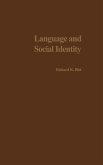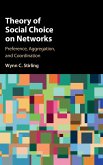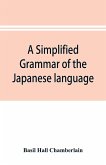- Gebundenes Buch
- Merkliste
- Auf die Merkliste
- Bewerten Bewerten
- Teilen
- Produkt teilen
- Produkterinnerung
- Produkterinnerung
This book focuses on the historical construction of language norms and its relationship to actual language use in contemporary Japan.
Andere Kunden interessierten sich auch für
![Language and Social Identity Language and Social Identity]() Richard K BlotLanguage and Social Identity101,99 €
Richard K BlotLanguage and Social Identity101,99 €![Theory of Social Choice on Networks Theory of Social Choice on Networks]() Wynn C. StirlingTheory of Social Choice on Networks76,99 €
Wynn C. StirlingTheory of Social Choice on Networks76,99 €![An English-Russian Digest of Military, Political & Social Terms An English-Russian Digest of Military, Political & Social Terms]() Bill St AmourAn English-Russian Digest of Military, Political & Social Terms29,99 €
Bill St AmourAn English-Russian Digest of Military, Political & Social Terms29,99 €![Hossfeld'S Japanese Grammar, Comprising A Manual Of The Spoken Language In The Roman Character, Together With Dialogues On Several Subjects And Two Vocabularies Of Useful Words; And Appendix (Volume Ii) Hossfeld'S Japanese Grammar, Comprising A Manual Of The Spoken Language In The Roman Character, Together With Dialogues On Several Subjects And Two Vocabularies Of Useful Words; And Appendix (Volume Ii)]() Henry J. WeintzHossfeld'S Japanese Grammar, Comprising A Manual Of The Spoken Language In The Roman Character, Together With Dialogues On Several Subjects And Two Vocabularies Of Useful Words; And Appendix (Volume Ii)21,99 €
Henry J. WeintzHossfeld'S Japanese Grammar, Comprising A Manual Of The Spoken Language In The Roman Character, Together With Dialogues On Several Subjects And Two Vocabularies Of Useful Words; And Appendix (Volume Ii)21,99 €![Remaking a Global Cantonese Community with Television and Social Media Remaking a Global Cantonese Community with Television and Social Media]() Simin LiRemaking a Global Cantonese Community with Television and Social Media34,99 €
Simin LiRemaking a Global Cantonese Community with Television and Social Media34,99 €![Grammar of the Japanese Language Grammar of the Japanese Language]() Diego ColladoGrammar of the Japanese Language14,99 €
Diego ColladoGrammar of the Japanese Language14,99 €![A simplified grammar of the Japanese language (modern written style) A simplified grammar of the Japanese language (modern written style)]() Basil Hall ChamberlainA simplified grammar of the Japanese language (modern written style)21,99 €
Basil Hall ChamberlainA simplified grammar of the Japanese language (modern written style)21,99 €-
-
-
This book focuses on the historical construction of language norms and its relationship to actual language use in contemporary Japan.
Hinweis: Dieser Artikel kann nur an eine deutsche Lieferadresse ausgeliefert werden.
Hinweis: Dieser Artikel kann nur an eine deutsche Lieferadresse ausgeliefert werden.
Produktdetails
- Produktdetails
- Verlag: Cambridge University Press
- Seitenzahl: 352
- Erscheinungstermin: 30. Juni 2016
- Englisch
- Abmessung: 235mm x 157mm x 23mm
- Gewicht: 661g
- ISBN-13: 9781107072268
- ISBN-10: 1107072263
- Artikelnr.: 45154002
- Herstellerkennzeichnung
- Libri GmbH
- Europaallee 1
- 36244 Bad Hersfeld
- gpsr@libri.de
- Verlag: Cambridge University Press
- Seitenzahl: 352
- Erscheinungstermin: 30. Juni 2016
- Englisch
- Abmessung: 235mm x 157mm x 23mm
- Gewicht: 661g
- ISBN-13: 9781107072268
- ISBN-10: 1107072263
- Artikelnr.: 45154002
- Herstellerkennzeichnung
- Libri GmbH
- Europaallee 1
- 36244 Bad Hersfeld
- gpsr@libri.de
Shigeko Okamoto is a Professor in the Department of Languages and Applied Linguistics at the University of California, Santa Cruz. She received her PhD in Linguistics from the University of California, Berkeley, in 1986. Her areas of research include sociolinguistics, discourse analysis, pragmatics and functional grammar. She has published numerous articles on Japanese language and gender, honorifics, regional dialects, grammaticization and grammatical constructions. She is a co-editor of the volume Japanese Language, Gender, and Ideology (with Janet S. Shibamoto-Smith, 2004). Her latest interest is in semiotic diversity and multiplicity and its relationship to language ideologies.
Introduction: toward a dynamic model of Japanese language and social meaning
Part I. The Notion of Nihongo
1. Standard Japanese and its others: building the national language
1.1 Standard Japanese: a building block in the making of modern Japan
1.2 Representations of standard and regional Japanese in the media
2. Standard and regional Japanese: diversity in attitudes and practice
2.1 Diversity in attitudes toward standard and regional Japanese
2.2 Meanings of standard and regional Japanese in practice: negotiating norms
Part II. Japanese Honorifics and Japanese 'Politeness': 3. Keigo: from official policy to popular pedagogy
3.1 Institutional policy on honorific form and use: constructing the Japanese essence
3.2 Keigo for the public: authoritative accounts by linguists
3.3 Honorifics: popular pedagogy
4. Keigo: diversity in attitudes and practice
4.1 Diversity in attitudes toward honorifics
4.2 Honorifics in practice: negotiating norms
Part III. Japanese Language and Gender: 5. Gendered Japanese: normative linguistic femininity and masculinity
5.1 Dominant narratives of gendered Japanese: a historical perspective
5.2 Media representations of gendered speech in contemporary Japan
6. Gendered Japanese: diversity in attitudes and practice
6.1 Diversity in attitude toward gendered speech
6.2 Meanings of gendered speech in practice: negotiating norms
Reflections: looking backward, looking forward.
Part I. The Notion of Nihongo
1. Standard Japanese and its others: building the national language
1.1 Standard Japanese: a building block in the making of modern Japan
1.2 Representations of standard and regional Japanese in the media
2. Standard and regional Japanese: diversity in attitudes and practice
2.1 Diversity in attitudes toward standard and regional Japanese
2.2 Meanings of standard and regional Japanese in practice: negotiating norms
Part II. Japanese Honorifics and Japanese 'Politeness': 3. Keigo: from official policy to popular pedagogy
3.1 Institutional policy on honorific form and use: constructing the Japanese essence
3.2 Keigo for the public: authoritative accounts by linguists
3.3 Honorifics: popular pedagogy
4. Keigo: diversity in attitudes and practice
4.1 Diversity in attitudes toward honorifics
4.2 Honorifics in practice: negotiating norms
Part III. Japanese Language and Gender: 5. Gendered Japanese: normative linguistic femininity and masculinity
5.1 Dominant narratives of gendered Japanese: a historical perspective
5.2 Media representations of gendered speech in contemporary Japan
6. Gendered Japanese: diversity in attitudes and practice
6.1 Diversity in attitude toward gendered speech
6.2 Meanings of gendered speech in practice: negotiating norms
Reflections: looking backward, looking forward.
Introduction: toward a dynamic model of Japanese language and social meaning
Part I. The Notion of Nihongo
1. Standard Japanese and its others: building the national language
1.1 Standard Japanese: a building block in the making of modern Japan
1.2 Representations of standard and regional Japanese in the media
2. Standard and regional Japanese: diversity in attitudes and practice
2.1 Diversity in attitudes toward standard and regional Japanese
2.2 Meanings of standard and regional Japanese in practice: negotiating norms
Part II. Japanese Honorifics and Japanese 'Politeness': 3. Keigo: from official policy to popular pedagogy
3.1 Institutional policy on honorific form and use: constructing the Japanese essence
3.2 Keigo for the public: authoritative accounts by linguists
3.3 Honorifics: popular pedagogy
4. Keigo: diversity in attitudes and practice
4.1 Diversity in attitudes toward honorifics
4.2 Honorifics in practice: negotiating norms
Part III. Japanese Language and Gender: 5. Gendered Japanese: normative linguistic femininity and masculinity
5.1 Dominant narratives of gendered Japanese: a historical perspective
5.2 Media representations of gendered speech in contemporary Japan
6. Gendered Japanese: diversity in attitudes and practice
6.1 Diversity in attitude toward gendered speech
6.2 Meanings of gendered speech in practice: negotiating norms
Reflections: looking backward, looking forward.
Part I. The Notion of Nihongo
1. Standard Japanese and its others: building the national language
1.1 Standard Japanese: a building block in the making of modern Japan
1.2 Representations of standard and regional Japanese in the media
2. Standard and regional Japanese: diversity in attitudes and practice
2.1 Diversity in attitudes toward standard and regional Japanese
2.2 Meanings of standard and regional Japanese in practice: negotiating norms
Part II. Japanese Honorifics and Japanese 'Politeness': 3. Keigo: from official policy to popular pedagogy
3.1 Institutional policy on honorific form and use: constructing the Japanese essence
3.2 Keigo for the public: authoritative accounts by linguists
3.3 Honorifics: popular pedagogy
4. Keigo: diversity in attitudes and practice
4.1 Diversity in attitudes toward honorifics
4.2 Honorifics in practice: negotiating norms
Part III. Japanese Language and Gender: 5. Gendered Japanese: normative linguistic femininity and masculinity
5.1 Dominant narratives of gendered Japanese: a historical perspective
5.2 Media representations of gendered speech in contemporary Japan
6. Gendered Japanese: diversity in attitudes and practice
6.1 Diversity in attitude toward gendered speech
6.2 Meanings of gendered speech in practice: negotiating norms
Reflections: looking backward, looking forward.








